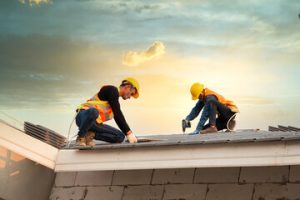Commercial roofing is an important element of a business’s infrastructure, safeguarding it from the elements and contributing to energy efficiency. It can be made of a number of different materials, each with its own advantages and disadvantages.

Throughout the 20th century, there were significant advances in commercial roofing materials. Older options like tar and gravel were replaced with alternatives that were easier to install and offered better durability. Contact Commercial Roofing Boston MA for professional help.
Commercial roofing is often a major investment for building owners, and installing or repairing commercial roofs requires a lot of time and effort. But even with the cost and time constraints, choosing the right materials for a commercial building’s roof is crucial to ensure durability and longevity. The type of roof you choose should be able to withstand extreme weather conditions, and it is important to consult with an experienced professional for proper installation or repair.
There are many different types of commercial roofing, ranging from traditional and tried-and-true choices like built-up roofs to innovative, high-tech options like green roofs and solar panels. The right commercial roofing system will not only protect your building’s structure, but it will also help you save money on energy bills and reduce your environmental footprint.
The history of commercial roofing is one of constant innovation. After World War II, demand for quick and cost-effective construction solutions skyrocketed, driving the industry to develop new methods and materials. In the 1960s, asphalt shingles, which were easier to install and provided a more attractive look, began to dominate the market. By the 1980s, the industry started to shift towards more sustainable and efficient construction practices. Cool roofing systems, which reflect sunlight rather than absorbing it, and single-ply membranes, which combine modern technologies with traditional ones, became popular.
Today, the focus of the roofing industry is on reducing a building’s energy costs. The roofing material you choose can have a big impact on how much your building consumes, so it is essential to do your research before making a decision. Some of the most popular roofing materials include metal cladding with insulation, rubber membranes, and single-ply materials like EPDM and PVC.
Commercial roofs must be able to withstand extremely high temperatures and intense wind, so it is important to choose a durable and reliable material. The best commercial roofing materials are made from metal or asphalt and are insulated, which helps prevent heat loss. The type of roof you choose depends on the climate in your region, and you can consult an experienced roofing contractor to find out which material will work best for your building.
Appearance
Commercial roofing comes in a variety of colors and styles to suit any property. It also offers energy efficiency and sustainability benefits for businesses looking to lower operational costs. It can be made of any type of material, but it is most often comprised of membranes such as EPDM or TPO. Membrane roofs are easy to install and provide durable protection from the elements.
Metal is another popular option for commercial roofing. It is highly durable, resistant to fire, and offers a variety of aesthetic options. Some types of metal can be insulated for added energy-efficiency. The most common metal roofing materials are galvanized steel and aluminum, but copper and stainless steel are also available. These roofing materials require periodic maintenance and repairs to keep them in top condition.
In the past, commercial buildings were outfitted with traditional shingles, slate, and clay tiles. Today, many commercial properties use modern membrane systems to improve insulation and boost energy efficiency. A growing number of companies are also using single-ply roofing materials that are environmentally friendly and easy to maintain. TPO roofing, for example, is a flexible and economical solution for low-slope commercial buildings. Its heat-welded seams prevent leakage and are highly protective against chemicals and other contaminants.
While the function of a commercial roof is similar to that of a residential roof, it has a different structure and is typically larger. It must support a wider range of equipment and facilities, including HVAC units and skylights. It must also comply with building codes and regulations. A specialized approach is required for a successful commercial roof installation and ongoing maintenance.
In addition to choosing a qualified contractor with experience in the type of commercial roof you need, it is important to find a contractor with a good track record and a commitment to safety and quality control. Ask the contractor about their warranty and guarantee policies and read customer reviews. The best contractors will offer warranties on both their materials and workmanship. This will give you peace of mind that your investment is protected. Also, look for a contractor with valid licensing and insurance to ensure that they operate legally and can protect you from liability.
Durability
Commercial roofing must be durable enough to handle heavy weather events like high winds and hail. Regular inspections and maintenance are essential for extending the durability of commercial roof systems. By implementing a preventative maintenance plan, building owners can identify signs of damage like sagging or leaks and take measures to repair them before the problem escalates. A proactive approach to roof care also helps uphold warranties on the material and installation, saving building owners money in the long run.
The durability of a commercial roof depends on its material and installation methods. There are a wide variety of materials to choose from, including metal, single-ply membranes, and asphalt shingles. Each type has its own pros and cons, but the best option for your building is usually based on the structure’s unique needs. For example, metal roofing is highly durable and energy-efficient. It is also resistant to fire and can withstand a variety of environmental factors, such as temperature changes and UV rays. Asphalt shingles are another popular option because they are inexpensive and easy to install. However, they are vulnerable to damage caused by temperature fluctuations and may require replacement every 15-20 years.
A single-ply membrane such as EPDM is a great choice for industrial buildings because it resists chemicals, fire, and sun damage. It is flexible and easy to install on flat or low-sloped roofs, and it is available in large sheets that reduce the number of seams. This material is also resistant to ozone and can last more than 25 years with proper maintenance.
While single-ply membranes are durable and aesthetically pleasing, they are more expensive than other types of roofing. Some types of single-ply membranes are also susceptible to thermal movement, which can lead to cracking and splitting.
Choosing a durable commercial roofing system is not only important for protecting the integrity of the structure, but it is also an excellent way to reduce energy costs. The right roofing material can significantly reduce cooling and heating costs, which can save a business significant amounts of money over time. It is also essential to hire a professional roofer who uses quality materials and installation techniques. A knowledgeable contractor can ensure that your commercial roof meets all necessary standards, including fire resistance, insulation, and drainage requirements.
Temperature
Commercial roofing is a vital part of any building. It protects the interior from external elements, enhances aesthetics, and helps regulate temperature, reducing energy costs significantly. However, many business owners take their roof for granted until it is leaking or in need of replacement.
A commercial roof can be made of a variety of materials, each with its own advantages and disadvantages. The choice of material can impact energy costs, lifespan, maintenance demands, and resilience to weather conditions. A professional can help you select the best commercial roofing for your building.
Denver’s fluctuating temperatures can test the limits of any roofing system. The sweltering summer heat, freezing winter temperatures, and intense UV exposure can affect everything from roof coatings to roof membranes and adhesives. Local commercial roofing contractors are familiar with the performance of different materials in these conditions, including asphalt shingles, bitumen, and single-ply roofing systems like TPO (thermoplastic polyolefin) and EPDM rubber.
Choosing the right insulation is another important aspect of commercial roofing. Insulation slows the flow of heat from hotter areas to cooler ones, which reduces energy costs and prevents moisture buildup. Commercial roofing insulation is rated according to its R-value, with higher values indicating better thermal efficiency. Architects and mechanical engineers often collaborate during the building’s design phase to determine an appropriate R-value for the project.
The most popular commercial roofing systems are metal cladding with insulation, asphalt shingles, and single-ply membranes. However, there are also green roofs, which can be designed to reduce stormwater runoff and improve air quality, as well as smart roofs, which come equipped with sensors that monitor weather conditions and energy usage.
It is best to install a new commercial roof during the spring or autumn, when the weather is milder. During the summer, contractors will need to work on top of the building when it is at its highest point in temperature, and they may need to take frequent breaks to avoid heat-related illnesses. Heat-related ailments include fatigue, thirst, heavy sweating, slurred speech, drowsiness, and in extreme cases, unconsciousness. Keeping up with seasonal inspections and repairs is an excellent way to keep your commercial roof in good condition and avoid costly damage.
